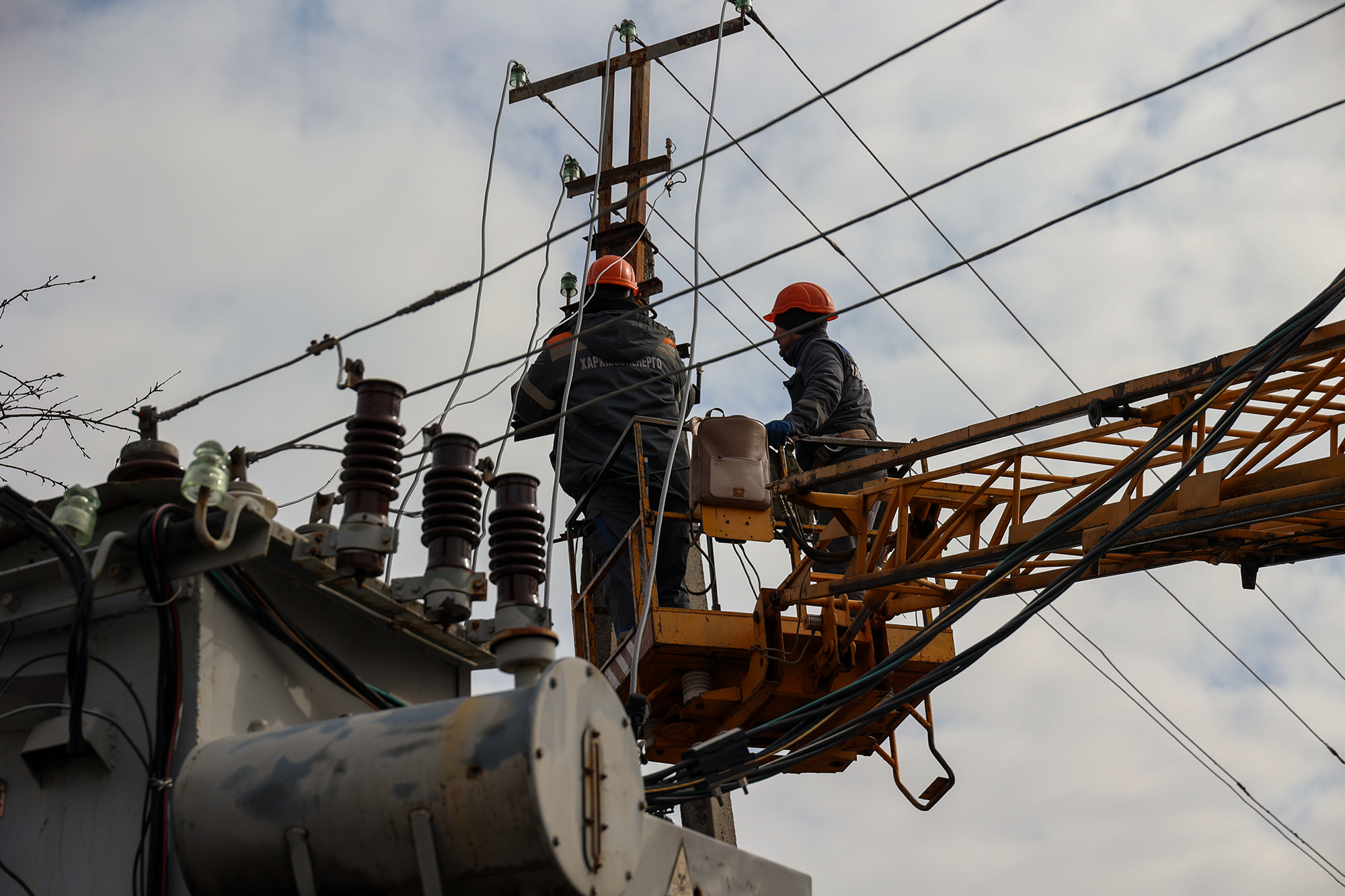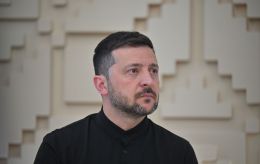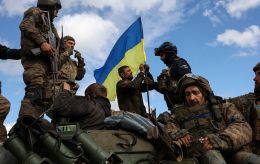Winter in Ukraine without power outages: Reality or excessive optimism
 Repairing equipment damaged by Russian shelling (photo: Getty Images)
Repairing equipment damaged by Russian shelling (photo: Getty Images)
The government promises that Ukraine will endure the winter with a normal electricity supply. They do not rule out the possibility of avoiding blackouts altogether. RBC-Ukraine analyzes the arguments for and against such forecasts.
Contents
- What could electricity shortage be like?
- Distributed generation: It will not be possible to reach 1 GW
- Polish project is frozen
- Government remains optimistic
Less than a month is left before the heating season starts in Ukraine. However, the prospects for energy supply in the fall and winter are not very promising. The degree of vulnerability of the energy system is very high. This is confirmed by the events of recent weeks.
On September 12, after several days of stable power supply, the Ukrenergo energy company had to resort to blackouts due to cloudy weather and, consequently, a decrease in solar generation. This indicates that the system is now practically at its limit.
In late October and early November, the air temperature will drop and electricity consumption will increase due to the active use of heating devices. It is unlikely that calls to save money will have any effect. In the summer, it was not possible to achieve a significant reduction in electricity consumption by refusing to use air conditioners. They accounted for 1.5 to 3 GW, which was almost a quarter of the total electricity consumption in summer.
In winter, the peak consumption will increase significantly. If in summer it was at the level of 12 GW, then the heating season may rise to 18 GW. At least that was the figure last winter.
International experts warn that Ukraine may face a very difficult situation with energy supply in winter. “Ukraine’s energy system has made it through the past two winters … But this winter will be, by far, its sternest test yet,” said Fatih Birol, head of the International Energy Agency.
What could electricity shortage be like?
It will not be possible to restore the destroyed generation facilities with a capacity of more than 9 GW by winter. DTEK, a private investor in the energy sector of Ukraine, which has almost 90% of its thermal power plants damaged to varying degrees, says that under an optimistic scenario, 50% will be restored.
Almost all hydroelectric power plants were also damaged by shelling. The Kakhovka HPP (335 MW) was completely lost, and the Dnipro HPP (almost 1.6 GW) was out of service. Other HPPs and PSPPs of Ukrhydroenergo are in the process of being restored, said the company's director Ihor Syrota. In total, according to official estimates, more than 40% of hydroelectric generation has been lost.
All repairs at the nuclear power plants are expected to be completed by the start of the heating season. Thus, all 9 nuclear power units under Ukraine's control should be able to operate in winter.
If the restoration work at all facilities is carried out to the maximum, the electricity shortage in winter may still be up to 35%, according to Yasno. Given that critical infrastructure must be supplied with electricity without restrictions, this figure will be 50% for the population, which means that blackouts may be up to 12 hours a day, said the company's director, Serhii Kovalenko.
 During blackouts in Ukraine (photo: Getty Images)
During blackouts in Ukraine (photo: Getty Images)
Some experts predict blackouts of up to 20 hours a day, as the UN Monitoring Mission also said the day before. But Ukrainian Energy Minister German Galushchenko considers such predictions groundless. “If there are no strikes that will critically affect the power system, we will go through this winter as normal. If there are, it is certainly difficult to predict the impact on the system of such strikes today,” Galushchenko said in early September, speaking to MPs.
Ukrainian Prime Minister Denys Shmyhal also asked to refrain from making pessimistic predictions. “No one today can talk about 4 hours, 16 hours, or no blackouts at all... It is wrong to predict and make sensational statements today, and we will not do so,” the Prime Minister explained.
Director of the Energy Research Center Oleksandr Kharchenko notes that the situation will depend on weather conditions. “God forbid, if frosts of 15-17 degrees last for 2-3 weeks, the deficit will be up to 6 GW, if it is from 0 to +5, the deficit will be 2-2.5 GW. And this is although everything will work (electricity generation and transmission facilities - ed.) more or less without technical problems,” he said in a comment to RBC-Ukraine.
However, the key factors that will affect the situation are the intensity of Russian shelling and the level of protection of the facilities. It is impossible to predict the activity of the Russians. And there is no detailed information in the public domain on the protection of the power system facilities. But, according to Volodymyr Kudrytskyi, former head of Ukrenergo, the first level of protection - gabions with sand (protecting against shell fragments) - has been installed at almost all facilities. The second level - reinforced concrete structures to protect against the Shahed - is installed only at Ukrenergo facilities. The construction of the third level of missile defense is currently suspended due to lack of funds.
However, even the installed protection does not guarantee the integrity of the facilities. According to a source familiar with the situation, the Russians are shooting quite accurately. There have already been cases when one Shahed broke through the barrier, and the second one almost freely passed through the resulting hole and hit the facility.
Distributed generation: It will not be possible to reach 1 GW
Another factor that will increase the resilience of the power system is the increase in distributed generation. This means installing gas piston and gas turbine generators. The former are usually low-powered - up to 10 MW, the latter are more powerful - up to 60 MW.
Volodymyr Zelenskyy announced plans to increase 1 GW of capacity by the end of the year through such mini-power plants in June. In the coming years, the volume of such generation, according to the President, may increase to 4 GW. But so far, there has been no significant progress in this direction.
 Volodymyr Zelenskyy speaks at the Ukraine Recovery Conference 2024 (photo: president.gov.ua)
Volodymyr Zelenskyy speaks at the Ukraine Recovery Conference 2024 (photo: president.gov.ua)
The initiative is being implemented at three levels. First, state-owned companies purchase, install, and put into operation the equipment: Gas Transmission System Operator of Ukraine, Ukrnafta, Naftogaz of Ukraine, and Energoatom. They are engaged in large generator sets. And today, these companies still have a minimal indicator. According to Kudrytskyi, as of September 12, they had installed only 60 MW of alternative generation. Only two companies have installed one facility each. Moreover, all work from procurement to the launch of one of them lasted more than a year and a half.
According to the RBC-Ukraine's sources, the amount of installed capacity by the end of the year may be in the range of 60-80 MW - no one gives exact figures for security reasons.
State-owned companies purchase equipment through tenders, which have not yet yielded significant results. Representatives of these companies in informal conversations with RBC-Ukraine emphasize the need to cancel tenders for such purchases. Sources familiar with the situation also say that tenders should be canceled because they take a lot of time due to the large number of formalities. But so far, RBC-Ukraine has not been able to confirm with the government that the tenders are planned to be canceled. Therefore, there is no reason to expect an increase in the procurement of small-scale generation facilities by state-owned companies.
The second level is where large private companies purchase equipment. They install alternative generation sources, primarily of their production. Having provided themselves with electricity, they can reduce the load on the general power system. Sources familiar with developments in the energy sector expect that private companies will be able to install equipment to generate 200 MW by the end of the year.
The third level is the installation of mini-power plants in the regions. Khmelnytskyi, Zhytomyr, and some other cities are already doing this. According to Kharchenko, the regions can install equipment to generate up to 140 MW, plus Kyiv - up to 120 MW. The RBC-Ukraine's sources in the energy sector cite comparable figures.
Thus, at best, only a little more than half of the announced 1 GW of capacity can be launched by the end of the year. Experts say the process will be more active next year. 1 GW or even more of distributed generation can be launched by the next heating season.
 Work to restore destroyed energy facilities in Ukraine (photo: Getty Images)
Work to restore destroyed energy facilities in Ukraine (photo: Getty Images)
Polish project is frozen
The initiative of Polish Prime Minister Donald Tusk could have slightly improved the situation with electricity. In July, he said that Poland was ready to produce electricity for Ukraine at its thermal power plants. But so far, no action has been taken to implement this project. “There is nothing new with this project, apart from the statements made by the Polish side back in the summer,” the source said.
There is little hope that it will be possible to establish electricity production in Ukraine. The RBC-Ukraine source noted that it is unlikely that the European Commission will meet Poland's demands and cancel the tax on harmful emissions generated by thermal power plants. In addition, the rules of access to the interstate crossing will need to be changed for electricity supplies. “Access is granted on a competitive basis, and in this case, it will be necessary to grant permanent access without any competition,” the source said.
Another way to slightly increase electricity in the system is through imports. It was expected that in September the technical capacity for imports would increase from 1.7 to 2.2 GW. But so far, ENTSO-E, the European network of operators, has not decided on this issue. And there is no particular need to increase imports now either. So far, it is not very profitable to sell electricity to Ukraine because its price in Europe is higher.
“And this is still a discouraging factor to raise the issue of increasing imports,” said a source familiar with the situation. However, he assured that if necessary, the issue of increasing technical capabilities for electricity supply to 2.2 GW would be resolved in a few days.
Government remains optimistic
Despite the risks of Russian shelling, lack of generation, and possibly even failure of repaired equipment, the government remains optimistic. Officials predict that there will be no problems with power supply by the end of October or even early November.
Under the optimistic scenario, which the government is still considering as a baseline, this winter will be just like the last one, with virtually no blackouts. They may occur only on days of severe frost - more than 10 degrees. This was stated on condition of anonymity by a senior Cabinet official.
The arguments in favor of this forecast were mentioned: a high level of protection of energy facilities, commissioning of additional generation, and increased imports. However, so far, positive expectations have not found concrete confirmation outside the government offices, either in the expert community or among energy market participants.
The industry has the impression that the government is rather trying to create an optimistic picture for the winter. To keep the period without power outages as long as possible, they are postponing the repair of equipment at one of the units of the South Ukrainian NPP. In late August, after another Russian attack, a circulation pump designed to remove heat from the reactor core was damaged.
This technical malfunction, which Energoatom called a remark on the operation of one of the units, does not affect the nuclear safety of the facility. However, it does not allow the unit to operate at full capacity, which is why it does not supply 400 MW of electricity to the system.
It will take several days to repair the pump, but this will require the reactor with a total capacity of 1 GW to be completely shut down, which will reduce generation by another 600 MW. These are the risks of a shortage in the system and the need for minimal outages.
Several sources have confirmed that it was decided to repair the pump at the unit only after all scheduled repairs at other stations have been completed. The postponement of the repair, although it is not the best option from a technical point of view, is explained by the need to avoid power outages as long as possible.
This approach is justified by the desire to maintain an uninterrupted power supply as long as possible.
However, postponing repairs, especially in the face of unpredictable shelling, is quite dangerous. First, it violates the regulations and increases the risks of equipment operation. Secondly, it can worsen the situation with outages in case of serious damage to the system due to possible shelling.

